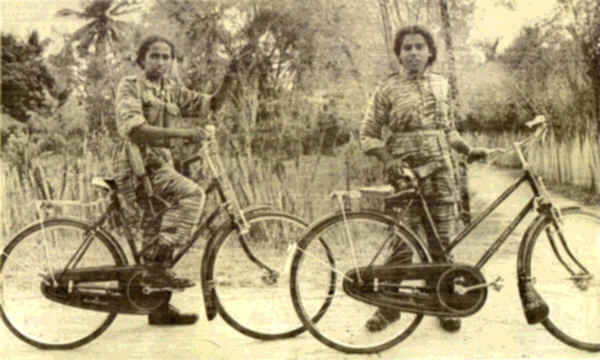 Women
LTTE
cadres,
early
1980s
(photo
courtesy
TamilNation.org)
Women
LTTE
cadres,
early
1980s
(photo
courtesy
TamilNation.org)by T. Sabaratnam
(Volume 2)
Three Factors
1984 is a milestone in the life of Pirapaharan and in the history of Tamil freedom struggle. In that year, as I indicated in Chapter 21, Pirapaharan switched over from hit-and-run guerrilla combat to sustained guerrilla warfare, and commenced the process of transforming the LTTE into a national liberation army. In that year he started building the structures - administrative, revenue, law and order and other measures - necessary for the establishment of a separate state.
Three factors helped Pirapaharan to commence the building of a national liberation army and the basic structures for a separate state. The first and foremost among them, as I have already pointed out, was the mobilization of the Tamil people behind him. Jayewardene and the daring deeds of the militant cadres did that for him. The riots of 1983 and the collective punishment meted out to the people by the police and the army drove the people behind Pirapaharan. The daring ‘hitting back’ his men dealt to the armed forces etched for him an indelible place in the hearts of the Tamil people.
The second and the third factors are also equally vital. They are: Indian military training and the vast amount of money Tamil Nadu Chief Minister M. G. Ramachandran (MGR) gave to Pirapaharan.
The pogrom hurt the pride and self-respect of the Tamil people and injured their feelings. Tamil youths from all parts of Sri Lanka, especially those who lived among the Sinhala people, flocked to the five main militant groups, to receive arms training to fight the Sinhala State and the Jayewardene government. The militant groups were then ill-equipped to admit all of these volunteers. "We did not have enough accommodation to house them. We did not have enough money to feed them," an EPRLF senior once told me.
Indian training came as a godsend to all the militant groups. TELO and PLOTE benefited most. They took in all who approached them. They did not worry about quality or commitment. They wanted to show India that they were big and influential. This enlistment strategy was the main cause for their failure. They had problems of discipline and were plagued with internal rivalries.
Pirapaharan was cautious and calculative. He screened all he admitted. He insisted on discipline and commitment. He admitted the number he could feed, house and train. The LTTE was thus relatively small at the beginning of 1984. Pirapaharan was not worried about the sudden swelling of the other militant groups.
Pirapaharan, says Anton Balasingham in War and Peace (Fairmax Publishing, Mitcham, Surrey, UK, 2004) was a "firm believer in the systematic evolutionary growth of the organizational structure, particularly the military. Abnormal expansion, in his view, would cause serious problems of discipline leading to disintegration."
Though small in size, Indian intelligence and Indian authorities rated the LTTE highly. Pirapaharan was well respected.
Four Indian intelligence agencies monitored the Tamil militant groups that functioned in Tamil Nadu from the beginning of the ‘eighties. They were:
1. Research and Analysis Wing (RAW), India’s external intelligence agency.
2. Central Intelligence Bureau (CBI), India’s internal intelligence agency.
3. Military intelligence
4. Q branch, Tamil Nadu’s intelligence agency.
All these agencies rated the LTTE as the most active, disciplined and committed for the their cause - the establishment of the separate state of Tamil Eelam.
K. Mohandas was the Deputy Director General of Police (Intelligence) in 1983. He was a Malayalee and was very close to MGR, a Kandy-born Malayalee. Mohandas had repeatedly told MGR that Pirapaharan’s LTTE was the best of the Tamil militant groups. Mohandas wrote a book after his retirement. In that book, MGR: The Man and the Myth (Panther Publishers, Bangalore, 1992, 181 pp), he recorded his assessment about the militant groups. This is what he records about the LTTE and its leader Pirapaharan:
The LTTE (Liberation Tigers of Tamil Eelam) was highly idealistic and well organized under its charismatic leader Velupillai Pirapaharan.
Mohandas had also praised the intelligence wing of the Tigers:
The various groups had their own intelligence wings but LTTE’s was the best.
The LTTE, which had a membership of less than 30 cadres before the 1983 July riots, expanded to about 250 by September of that year. Pirapaharan selected the senior 200 cadres for specialized training in Uttar Pradesh.
The LTTE was the last to join Indian training. Pirapaharan sent his men in November 1983 in two batches of 100 each. He acted with foresight. He asked Chandrasekaran, RAW’s top official who coordinated with him, about the nature of the Indian military training. Chandrasekaran told him that highly skilled Indian officers would provide the training in all aspects of modern warfare. Chandrasekaran added that specialized training would be provided in the use of small and heavy weapons. The training program would include map reading, mine-laying and the use of explosives, and anti-tank and anti-aircraft weapon systems.
Pirapaharan told Chandrasekaran about the LTTE’s priorities. He told Chandrasekaran that his immediate concern was to safeguard the civilians from the army’s retaliatory attacks. "We must push the army back to its camps," he told Chandrasekaran.
Pirapaharan’s vision was to transform his guerrilla force into a national liberation army, to liberate the Tamil homeland from Sri Lankan control and to establish an independent state of Tamil Eelam. His vision is embodied in the constitution he drafted for the LTTE on 5 May 1976 at the age of 21 years. The objectives enumerated in the constitution are:
Pirapaharan divided the military activities of the LTTE into three main divisions. They were;
- Refer to Pirapaharan Vol 1 Chapter 4.
Pirapaharan was clear in his mind that Indian training should be made use of to achieve his vision of transforming the guerrilla force he commanded into a national liberation army. He programmed his scheme for the training to suit his vision. He designed the training requests carefully to fit into his planned course of action.
Indian trainers taught the LTTE’s now battle-hardened men specialized skills on landmine manufacture, the mining of roads and bridges and the use of explosive devices. Pirapaharan made use of these skills to launch the landmine war that restricted the movements of the police and the army and confined them by mid-1985 to their stations and camps.
 Women
LTTE
cadres,
early
1980s
(photo
courtesy
TamilNation.org)
Women
LTTE
cadres,
early
1980s
(photo
courtesy
TamilNation.org)
Indian training built on the knowledge and expertise of the LTTE fighters. It improved their military capacity and capability. The Indian training program was limited, however. Indians trained only 200 fighters. The weapon systems on which they were trained were outdated. The weapons issued to the LTTE cadres were old.
Pirapaharan needed more men and sophisticated weapons to realize his vision. He needed at least 1000 men and modern weapons. For that he needed money, but money was not available. He was finding it difficult, at that time, to manage day-to-day affairs. But in April, 1985 Pirapaharan struck a gold mine. MGR came to his rescue. I will relate that story in the next chapter.
The massive funds MGR injected helped Pirapaharan to start training camps, recruit more cadres and expand his political work.
Military Decisions
Emboldened by MGR’s help, Pirapaharan took two sets of decisions, military and political, to take forward the freedom struggle. The basic elements of his military decisions were:
The basic elements that formed the political decisions were:
The training of cadres and the purchasing of weapons were Pirapaharan’s priority concerns. He had already set up two training camps in Tamil Nadu, one at Sirumalai in Dindukal in the Madurai district and the other at Kulatur near Mettur, Salem district. The Sirumalai Camp was established with the help of Nedumaran and the Kulatur Camp with the help of Kulatur Mani, a prominent supporter of the Dravida Kazhalagam. Nedumaran organized the supply of food and other essential needs of the Sirumalai Camp and Mani organized them for the Kulatur Camp.
Pirapaharan expanded the Kulatur Camp in January 1984 and commenced the first major training program in Tamil Nadu. A batch of 125 cadres was taken in for training. This batch is referred to as the third batch. The two batches that underwent training in Uttar Pradesh are counted as the first two batches. The training was of six months duration.
Lt.
Col.
S.
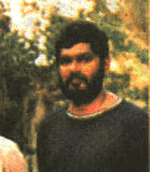 Ponnamman
(photo
courtesy
TamilCanadian.com)
Ponnamman
(photo
courtesy
TamilCanadian.com)
Ponnamman was placed in overall charge of establishment of the camps. Pirapaharan, as we will see as we go on, believed in a highly decentralized form of administrative machinery. He apportioned the areas of responsibility into different departments and appointed his trusted men as heads of those sections. Ponnamman took charge of the Kulatur and Sirumalai camps. He was also one of the instructors. Kumarappa, Pulenthiran, Kittu, Lingam and Ragu who were trained in Uttar Pradesh were the main trainers. Pirapaharan visited the camp often and instructed the cadres on weapon usage and maintenance. His demonstrations on pistol shooting were considered a treat by the cadres and instructors. Pirapaharan hired Nayik, a commissioned officer to oversee the training.
With the flow of MGR’s funds Pirapaharan expanded Sirumalai Camp in July 1984 and established two satellite camps thereafter at Thiruparankunram and Azhalagarmalai, two of the six sacred abodes of the Hindu God of action, Murugan.
The third batch completed its training in July 1984 and was posted to Jaffna in the end of that month. Kittu returned as the head of that batch and was placed as deputy to Pandithar who was in command of the Jaffna peninsula. Pandithar functioned from Atchuveli Camp. The return of this batch marked the intensification of the attacks on the army and the beginning of Pirapaharan’s ideal of liberating civilian areas from army control and bringing them under LTTE control
The fourth batch of 125 cadres, which received training at Sirumalai from July 1984 to the end of the year, returned to Jaffna in December. This boosted the number of LTTE guerrillas to about 500 and in 1985 the LTTE succeeded in confining the policemen to their stations and in pushing the army into their camps.
In September 1984 Pirapaharan recruited more cadres and intensified the training program. In that month a new camp was established at Kumarapiddy and three batches, the fifth, sixth and seventh, were admitted for training. The number trained was larger than before. The fifth batch which received training at Kumarapiddy comprised 200 cadres. The sixth batch which received training at Kulatur was the largest. Three hundred and fifty cadres were trained in that batch.
The seventh batch was the LTTE’s first Women’s Brigade. It comprised 100 girls. That was the first time an exclusive military training camp was conducted for women. The training was given in the Sirumalai Camp. Victor, Mannar Commander, was placed in charge of the training camp.
In 1984, five batches were trained in the LTTE camps in Tamil Nadu. A total number of 900 cadres, including 100 girls were trained in these camps. By the end of 1984, the LTTE had consolidated itself. It had increased its strength to over 1000 fighters. Yet it was smaller than TELO, PLOTE and EPRLF which had around 6,000 cadres each. At the end of 1984, Tamil militant groups had a total strength of about 30,000 cadres, twice the number of soldiers in the army. The total strength of the army when Lalith Athulathmudali was appointed Minister of National Security in March 1984 was less than 15,000 men.
While expanding the training facilities in Tamil Nadu Pirapaharan was busy building transport and supply routes between Tamil Nadu and Sri Lanka. Until the July, 1983 riots, th LTTE used fishing boats or the boats owned by smugglers to travel back and forth. After the riots, Pirapaharan decided to build and operate his own boats. The first boat constructed by the LTTE was named Kadal Pura, the name of the boat the Chola kings used to transport their army to the Far East. Several speedboats were built after that. Shankar was given charge of boat construction.
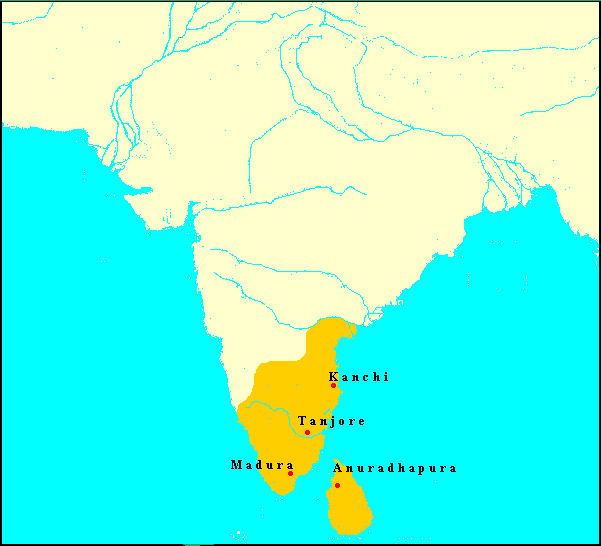 Chola
Empire,
11th
century
AD
Chola
Empire,
11th
century
AD
Pirapaharan also visualized the need for a shipping service. He needed to smuggle in weapons and transport supplies. He also wanted to generate funds for the struggle. He was conscious from the start that he was going to wage a war against a state and he would have to match its resources. Depending solely on the Tamil people would be risky. He planned income-generating measures to supplement taxes and contributions from the people. He started a shipping line in 1984.
The LTTE started its first shipping company in Southeast Asia. MV Cholan was the first ship bought by that company. The company bought an old ship from China, refurbished it, registered it in Panama and used it to carry weapons and merchandize. The LTTE later added ten more ships to its fleet.
The LTTE also developed its supply routes between Tamil Nadu and northeastern Sri Lanka. Vedaraniyam and Nagapatinam on the Tamil Nadu coast and Polikandy, Manalkadu and Valvettithurai in the Jaffna peninsula were developed as the landing sites to move cadres and supplies between Tamil Nadu and Sri Lanka. The fishing villages of Vettilaikerni, Mathagal Pasaiyur, Colombothurai, and Myliddi were also used as landing sites. Supplies were distributed by speedboats from Valvettithurai to landing sites in Mullaitivu, Trincomalee and Batticaloa.
Buying Weapons
Pirapaharan made a conscious decision to buy weapons in the early part of 1984. India decided to supply arms to Tamil militant movements in March when it became clear that Jayewardene was making use of the All Party Conference to buy time to strengthen the armed forces and opt for a military solution. Elated LTTE cadres conveyed the news to Pirapaharan. He listened to the story and commented, "We should buy arms immediately from outside sources."
Shocked, cadres enquired, "India is giving us arms. Why do we need to buy from outside?"
Pirapaharan replied, "India is giving us arms in order to keep us under its control. It will also give us arms necessary to serve its objectives. We cannot be India’s mercenaries. We must buy arms and build up our weapon capacity to enable us to stand on our legs."
In later discussions, he expounded his thinking. He explained to them the conflict between their aims and objectives and that of India. He said their objective was the establishment of an independent state for the Tamils of Sri Lanka. India will never support such an objective. India’s aim was to keep Sri Lanka within its orbit of influence. If Mrs. Bandaranaike had been in power, India would not have bothered to train or arm the militants. If Jayewardene returned to a non-aligned policy and accepted India as the regional power, India would turn the other way and ignore the plight of the Tamil people.
Pirapaharan explained that India wanted to make use of the Tamil militants to pressure Jayewardene to respect Indian interests. The Indians would give the Tamil militants the weapons necessary to exert such pressure on Jayewardene. They would not issue the weapons that could be used to drive the army out of the Tamil homeland. Pirapaharan said that the LTTE would accept the weapons India provided and buy the arms necessary to drive the army out of Tamil territory.
The quantity of the weapons India supplied was small and the quality was poor. "Pirapaharan was deeply disappointed with the weapon systems," says Balasingham in his War and Peace. "Most of the rifles, machine guns and mortars (60mm) were antiquated and unusable," Balasingam told me. "We realized that the Indian authorities did not want to provide modern, sophisticated weapon systems. It was a calculated policy to restrain the military capability of the Tamil rebel movement to a particular level of development. For Pirapaharan, who entertained a vision of creating an elite fighting formation with modern weapon systems, Indian military inputs were totally inadequate."
Pirapaharan wanted to buy modern weapons from the world market. Money was his dogging problem. MGR provided the funds. (For details await the next chapter). With MGR’s money Pirapaharan bought the latest weapons from the illicit weapon market in Lebanon. He set up the top-secret Arms Procuring Unit for that purpose under K. Pathmanathan (known as KP) who continues to hold that position even today.
KP visited all the black markets in the world and made his buys from Lebanon because it was cheap and reliable. KP's name, aliases, identity, whereabouts and other details soon got into the files of world’s intelligence services. He is credited with having a Sri Lankan and two Indian passports. He is widely travelled and well known in the illicit arms market.
KP’s first purchase was a container-load of AK47s and RPGs (Rocket Propelled Grenades), sniper rifles, explosives, night vision devises, anti-tank weapons, advanced radio and communication systems and ammunition. It was brought to the Chennai harbour by a foreign ship. The LTTE tried its best to get the shipment cleared, but failed. The Customs officials who were helping the LTTE were reluctant to assist. They were scared because a container-full of arms imported by Uma Maheswaran had been seized by the Customs the previous month. Ultimately LTTE got the shipment cleared with the help of MGR. Details of that incident are also given in the next chapter.
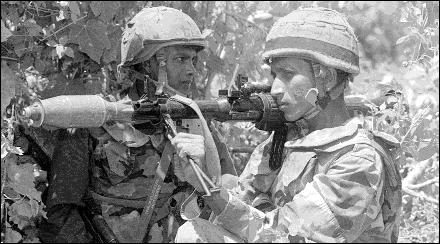 Sri
Lankan
soldier
with
an
RPG,
1998
Sri
Lankan
soldier
with
an
RPG,
1998
Pirapaharan, as I have pointed out earlier, is a devotee of the Hindu God of action, Murugan. He vowed that he would go on a pilgrimage to the Murugan Temple at Palani if the container of weapons was cleared. He fulfilled the vow as soon as the container reached the LTTE hideout. He spent a day fasting, praying and thanking Murugan for helping him to get the weapons cleared. He also thanked MGR.
A top LTTE cadre told me that MGR telephoned the Customs Commissioner and the Director General of the Police. The container was not only released, but was transported to an LTTE safe house under police escort at night. The safe house could not accommodate all the weapons. Excess weapons were taken to Balasingham’s house. Adele Balasingham refers to this incident in her The Will to Freedom thus: "Indeed on one occasion the rooms in our house were full of AK 47s and rocket propelled grenades," she says. The weapons were quickly transferred to the various arms dumps in Tamil Nadu and Sri Lanka. The LTTE bought large quantities of gelatin, the explosive used in Tamil Nadu to blast rocks.
Pirapaharan restructured the LTTE following the induction of fresh men and weapons. He divided the northeast into five zones and appointed commanders for each zone. Jaffna peninsula was under Pandithar, the Vanni under Mahattaya, Mannar under Victor and Trincomalee under Santhosam. The other zone was Batticaloa- Ampara.
State Structures
While engaged in this massive effort to transform the small guerrilla force into a national liberation army, Pirapaharan put equally gigantic effort to build the basic structures for a separate state. He had liberated a large extent of the rural areas in the northern and eastern provinces from police and army control. In the Jaffna peninsula, only seven of the 16 police stations were functional. Thepolice in these stations entertained complaints, but refrained from conducting investigations. They stopped filing fresh cases in the magistrate courts, which continued hearing old cases. The police also abandoned traffic duties. They continued with their mobile road patrol with army protection. The army also did their rounds in convoys of jeeps and armoured cars.
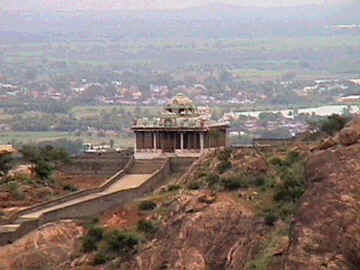 Palani
Murugan
Temple
Palani
Murugan
Temple
Anti-social elements revelled in this situation. Robberies, intimidation, collection of protection money (kappam) by thugs, rapes and other serious crimes multiplied. The LTTE and PLOTE took upon themselves the task of protecting the people from anti-social elements. The LTTE issued a leaflet in March 1984 warning criminals to desist from their activities. It warned that failure to heed the warning would result in their destruction.
A few days after the issue of the warning leaflet a body was found tied to a lamp post at Atchchuveli junction. The body had gunshot wounds to its head.
A note found near the body bore the Tiger emblem. The note read: Punishment given for robbing the public at gunpoint." The victim was 28-year-old Ponnambalam Nadarajah.
Gunaratnam of Kalviyankadu, Jaffna also ignored the LTTE warning. The 29-year-old Gunaratnam, popularly known as Kukku, continued with his robberies. He entered a house in Navaly during daytime, attacked a young woman who was alone, and walked away with her jewellery worth over 100,000 rupees.
Two days later two youths stopped Kukku as he stepped out of a tea boutique. He recognized the youths and started running. One of them shot Kukku and he fell dead. The youths tied his body to a lamppost and placed a handwritten note on the head. It read: We warned him thrice. He did not listen. So, we punished him." The letter had the Tiger emblem.
PLOTE also punished a few anti-social elements. Sinnaiah Sivapalan, 21, was from Chulipuram. He was found dead with gunshot injuries at Chulipuram junction. A note placed by his side enumerated his crimes. He had robbed jewellery from several houses in the area, raped a young woman from Chulipuram and robbed vehicles, it said. The note said the death sentence had been pronounced by the Sangilian Panchayat, a PLOTE organization.
Maintenance of law and order gradually became the concern of the LTTE. It also revived the ancient mechanism for dispute resolution, the panchayat system. Village elders were encouraged to resolve civil and minor criminal disputes.
The LTTE also encouraged civil society to play an active role in highlighting human rights violations, the needs of the people, making representations about the hardships brought about by governmental actions and acting as a coordinator between the Sri Lanka government and the people. Citizen’s Committees sprouted in all cities in the north and east. Respected citizens of the area got together and formed the Citizen’s Committees. The LTTE encouraged their formation. Pirapaharan, who was in Tamil Nadu, placed Mahattaya, his deputy, to be in charge of liaising with these Committees.
The Citizen’s Committees grouped themselves into the Jaffna Citizen's Committee and the Citizen's Committee for the East. Later the Coordinating Committee of Citizen's Committees for the Northeast was formed. Prof. K. Sivathamby was elected the head of the Jaffna Citizen’s Committee and S. Sivapalan the chief of the Citizen’s Committee for the East. Sivathamby and Sivapalan jointly headed the Coordinating Committee.
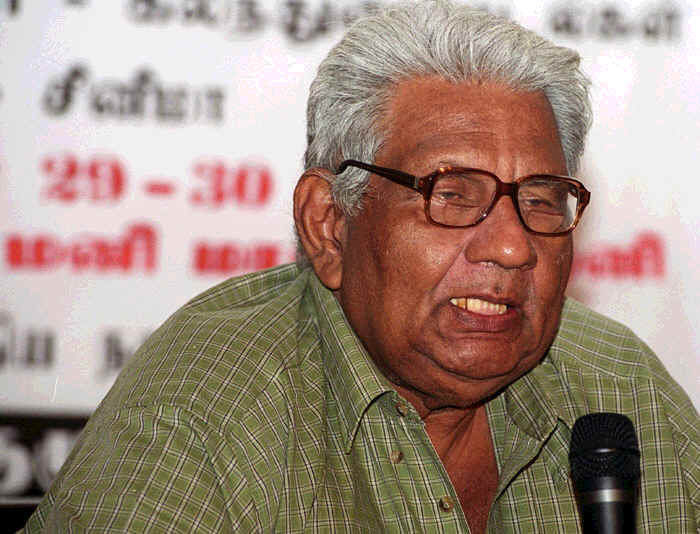 Prof.
K.
Sivathamby,
2003
(photo
courtesy
TamilNet.com)
Prof.
K.
Sivathamby,
2003
(photo
courtesy
TamilNet.com)
The Coordinating Committee, which won the acceptance of the people, the LTTE and the government later assumed the role of a watchdog organization and humanitarian activist. Its representatives visited youths detained in police stations and army camps which helped to reduce police and army torture. It acted as a coordinator between foreign humanitarian institutions, the LTTE and the government. It also played an important role in resettling displaced persons and in the welfare of refugees.
With the liberation of a large extent of territory from the control of the Sri Lankan government, the people living in those areas were freed from paying taxes to the government. The LTTE, which took over the function of protecting the people, collected a defence levy and other taxes normally collected by a state. It imposed a sales tax on goods produced locally and an import duty on goods brought into the areas under its control.
The Sri Lanka government was naturally worried about this tax collection. It said tax collection is the legitimate function of the government alone and the LTTE had no right to such revenues. The government charged that the LTTE was extorting money from the people. The LTTE continued to collect the taxes. By doing so, the LTTE exercised a basic function of state power; revenue collection.
With defence of the people, maintenance of law and order and collection of revenue Pirapaharan took over the essential structures of the state. He systematically developed these structures and now (in 2004) he is busy strengthening them.
Political Activity
Pirapaharan used part of the funds MGR provided to strengthen the LTTE’s political section. The political office in Chennai was expanded and strengthened. Balasingham was in control of the political activity. A monthly publication, Viduthalai Puligal was started in Tamil and an English language publication Voice of Tigers was also printed. A radio broadcast named Puligalin Kural was started. An in-house, magazine Porkural was set up to educate the cadres.
A separate publicity unit was initiated. A group of specialist still and video photographers were ordered to record the LTTE’s attacks. The photographic albums and video films produced by that unit were used for propaganda and to generate funds.
By December 1984, the LTTE commenced the process of involving the people in the freedom struggle. Boys were made use of to maintain information boards in public places. They were also taught to watch police stations and army camps. Some of them were provided with walkie-talkies. Their duty was to inform the militants if the police or the army tried to move out of their stations or camps. People were mobilized to set up roadblocks to restrict the movement of the police and the army. Militants exploded landmines and threw hand grenades to prevent the army getting out of their camps.
1985 was another landmark year in the history of the Tamil struggle. The police and the army were pushed into their stations and camps. If not for Indian intervention the entire northeast would have fallen into the hands of the Tamil militants. India told Tamil militant leaders firmly that their role was to push Jayewardene to the negotiation table and nothing more. India saved the situation for the Sinhalese. Before we proceed to that story I will relate the details of MGR’s role in the Tamil Eelam struggle and the media interview he gave Anita Pratap.
Next
Chapter 27. MGR’s Role in the Eelam Struggle
To be posted December 3